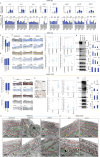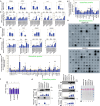HSPA2 influences the differentiation and production of immunomodulatory mediators in human immortalized epidermal keratinocyte lines
- PMID: 40287440
- PMCID: PMC12033329
- DOI: 10.1038/s41419-025-07565-5
HSPA2 influences the differentiation and production of immunomodulatory mediators in human immortalized epidermal keratinocyte lines
Abstract
Chaperone proteins constitute a molecular machinery that controls proteostasis. HSPA2 is a heat shock-non-inducible member of the human HSPA/HSP70 family, which includes several highly homologous chaperone proteins. HSPA2 exhibits a cell type-specific expression pattern in the testis, brain, and multilayered epithelia. It is a crucial male fertility-related factor, but its role in somatic cells is poorly understood. Previously, we found that HSPA2 deficiency can impair epidermal keratinocyte differentiation. In this study, we confirmed the crucial role of HSPA2 in keratinocyte differentiation by investigating immortalized keratinocytes cultured in a reconstructed human epidermis model. Moreover, we uncovered the influence of HSPA2 on immunomodulation. Transcriptomic analysis revealed that the total loss of HSPA2 affected the expression of genes related to keratinocyte differentiation and interleukin- and interferon-mediated signaling. The functional analysis confirmed bidirectional changes associated with the loss of HSPA2. The HSPA2 knockout in HaCaT and Ker-CT keratinocytes, but not HSPA2 overproduction, impaired granular layer development as evidenced by reduced levels of late keratinocyte differentiation markers, filaggrin and involucrin, along with structural abnormalities in the upper epidermal layer. Differentiation defects were accompanied by increased mRNA expression and extracellular secretion of keratinocyte-derived pro-inflammatory IL-6 cytokine and CCL2, CCL8, CXCL1, CXCL6, and CXCL10 chemokines. The loss of HSPA2 also led to increased expression of extracellular HSPA1 and interferon-stimulated genes and secretion of immune cell modulator SLAMF7. Knocking down HSPA1 expression in keratinocytes decreased the secretion of IL-6 and CCL5 release, suggesting extracellular HSPA1's role in the HSPA2-regulated molecular network. To summarize, we uncovered the complex homeostatic role of HSPA2 in epidermal keratinocytes. Our results suggest that dysfunction in HSPA2 activity could be an important pathogenicity factor and potential therapeutic target for inflammatory cutaneous diseases.
© 2025. The Author(s).
Conflict of interest statement
Competing interests: The authors declare no competing interests. Ethical approval: All methods were performed in accordance with the good scientific conduct guidelines and regulations. This study does not involve animals and human participants or human data; therefore, informed consent for participation and publication is not applicable.
Figures









Similar articles
-
Novel role for the testis-enriched HSPA2 protein in regulating epidermal keratinocyte differentiation.J Cell Physiol. 2018 Mar;233(3):2629-2644. doi: 10.1002/jcp.26142. Epub 2017 Sep 7. J Cell Physiol. 2018. PMID: 28786487
-
The human testis-enriched HSPA2 interacts with HIF-1α in epidermal keratinocytes, yet HIF-1α stability and HIF-1-dependent gene expression rely on the HSPA (HSP70) activity.Biochim Biophys Acta Mol Cell Res. 2024 Jun;1871(5):119735. doi: 10.1016/j.bbamcr.2024.119735. Epub 2024 Apr 18. Biochim Biophys Acta Mol Cell Res. 2024. PMID: 38641179
-
Cell type-dependent modulation of the gene encoding heat shock protein HSPA2 by hypoxia-inducible factor HIF-1: Down-regulation in keratinocytes and up-regulation in HeLa cells.Biochim Biophys Acta. 2015 Sep;1849(9):1155-69. doi: 10.1016/j.bbagrm.2015.07.004. Epub 2015 Jul 9. Biochim Biophys Acta. 2015. PMID: 26164067
-
Heat shock proteins in the physiology and pathophysiology of epidermal keratinocytes.Cell Stress Chaperones. 2019 Nov;24(6):1027-1044. doi: 10.1007/s12192-019-01044-5. Epub 2019 Nov 16. Cell Stress Chaperones. 2019. PMID: 31734893 Free PMC article. Review.
-
Expression, function, and regulation of the testis-enriched heat shock HSPA2 gene in rodents and humans.Cell Stress Chaperones. 2015 Mar;20(2):221-35. doi: 10.1007/s12192-014-0548-x. Epub 2014 Oct 25. Cell Stress Chaperones. 2015. PMID: 25344376 Free PMC article. Review.
References
-
- Kodiha M, Chu A, Lazrak O, Stochaj U. Stress inhibits nucleocytoplasmic shuttling of heat shock protein hsc70. Am J Physiol Cell Physiol. 2005;289:C1034–41. - PubMed
-
- Scieglinska D, Piglowski W, Mazurek A, Malusecka E, Zebracka J, Filipczak P, et al. The HspA2 protein localizes in nucleoli and centrosomes of heat shocked cancer cells. J Cell Biochem. 2008;104:2193–206. - PubMed
-
- Hightower LE, Guidon PT Jr. Selective release from cultured mammalian cells of heat-shock (stress) proteins that resemble glia-axon transfer proteins. J Cell Physiol. 1989;138:257–66. - PubMed
MeSH terms
Substances
Grants and funding
- 2017/25/B/NZ4/01550/Narodowe Centrum Nauki (National Science Centre)
- 2017/25/B/NZ4/01550/Narodowe Centrum Nauki (National Science Centre)
- 2017/25/B/NZ4/01550/Narodowe Centrum Nauki (National Science Centre)
- 2017/25/B/NZ4/01550/Narodowe Centrum Nauki (National Science Centre)
- 2017/25/B/NZ4/01550/Narodowe Centrum Nauki (National Science Centre)
LinkOut - more resources
Full Text Sources
Miscellaneous

